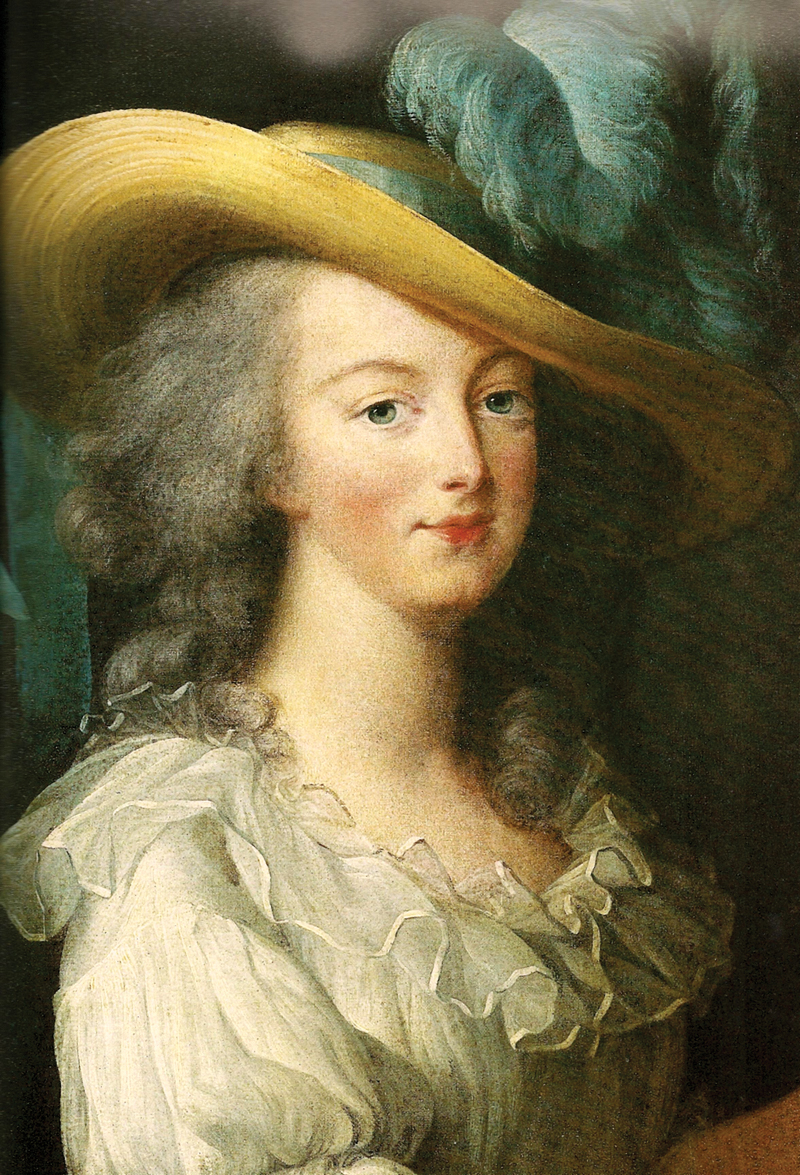
On a warm spring morning in 1900, an influential group of 15 Central Florida women and men gathered at a lakeside Maitland estate to grapple with a troubling issue — the wanton destruction of the state’s beautiful birds.
The smell of orange blossoms likely wafted through open windows and birds chirped nearby as the concerned group of 15 formed the Florida Audubon Society.
Today, Maitland’s original Florida Audubon Society has morphed into Audubon Florida, with a policy office in Tallahassee and an administrative office in Miami. Audubon Florida also operates the Audubon Center for Birds of Prey in Maitland (see pages 22-23).
There are 44 local Audubon chapters statewide, encompassing more than 61,300 members. The Orange Audubon Society, which usually meets monthly in Leu Gardens, is the closest local chapter. There’s also a Kissimmee Valley Audubon Society in Osceola County.
But it all started 118 years ago with a handful of nature-loving locals appalled at the fact that birds were being killed by the hundreds of thousands to supply plumes and bodies to decorate popular ladies’ hats.
FAS founders were attracted to subtropical Florida in part for its weather and in part for its beauty. Some visited simply to escape harsh Northern winters, while others pondered development schemes or cultivated orange groves.
All shared a deep affection for birds, and were enchanted at the variety of bird life they could view literally in their own backyards. They strolled along lakes to seek colorful Carolina parakeets, and watched in wonder as graceful egrets stalked fish in shallow waters.
But the birds were in serious trouble; indeed, the last Carolina parakeet would die in the Cincinnati Zoo in 1918. It was time to act — and act quickly.
Summoned by Clara Dommerich on March 2 to her winter home, known as Hiawatha Grove, the group agreed that its first course of business was to create FAS — and begin a public education program to “arouse as much interest as possible in the work of protecting our feathered friends.”
Clara and her husband, Louis, both German immigrants, were New York City residents who wintered in Maitland. They grew citrus on their 400-acre tract — now the sprawling Dommerich Estates subdivision — where they enjoyed wild birds such as cranes, owl, quail, doves and turkey.
Every morning, Louis would fill bird-feeding stations on his porch — then whistle to summon eager cardinals, blue jays and juncos.
The first FAS president, the Rt. Rev. Henry B. Whipple, Episcopal Bishop of Minnesota, was also an avid birder. “No state or territory in our country has been so richly endowed in plumage and song birds as this state,” he wrote, recalling the creation of FAS.
“At my first visit to Florida, 50 years ago, I saw at almost every turn on the St. Johns River, the pink and white curlews, and scores of other brilliantly plumaged birds. Within the past 20 years I saw, on one occasion, in the woods bordering Lake Jessup, not less than 2,000 paroquets (parakeets).”
But by 1900, Whipple sadly recounted, “Many of these beautiful creatures are no longer to be found, unless in the Everglades. The murderous work of extermination has been carried on by vandals, incited by the cupidity of traders who minister to the pride of thoughtless people.”
It was that familiarity with Florida’s natural richness and knowledge of the perils it faced, mostly from the national and international millinery industry, that spurred the FAS founders.
Men and women had long been adorning their headwear — military for men, and everyday clothing and hats for women — with feathers, and even the bodies of birds. In the 18th century, Marie Antoinette, nicknamed “featherhead” by her brother, set the trend in court for women to wear feathers in their elaborate hairstyles.
Bird wear was revived in the late 19th century, and endorsed by fashion houses, celebrities and national magazines. Bird plumes, especially showy “aigrettes” that wading birds displayed during mating season, were extremely valuable.
Hunters living hardscrabble lives in Florida wetlands and coastal marshes could make a living by shooting birds that congregated in nesting rookeries, then stripping off the birds’ valuable plumes and leaving the carcasses — and babies and eggs — behind.
Feathers and bird parts were shipped to northern markets in a $17-million-a-year industry that employed an estimated 83,000 people in 1900. One London firm reported that 1.5 tons of aigrettes passed through its sales room one year — the equivalent of almost 200,000 birds.
In 1886, according to one anecdote, ornithologist Frank Chapman — curator of the American Museum of Natural History — spent two afternoons prowling New York City shopping areas, observing birds on women’s hats. Three-quarters of the 700 hats he counted were decorated with feathers plucked from 40 different kinds of birds — including sparrows and warblers.
This was big business, and Florida was ground zero for much of the destruction.
By 1900, several Audubon societies had sprung up in 20 states to fight this senseless destruction. The fathers and mothers of FAS, much like their counterparts elsewhere, were influential community members who sought to gain local, state and national attention for their cause.

They would be described 25 years later as “a little group of people who had a vision for the future.” They were passionate, wealthy, driven by their concerns about dwindling bird populations — and well-connected enough to make an impact.
Whipple was likely the most influential of all. In the 1870s, the aging bishop built a home in Maitland as a winter respite. In 1883, he founded the Church of the Good Shepherd — which still stands on Lake Avenue — in memory of his son.
Always an activist, Whipple had pushed for reforms in U.S. relations with the native Indians. He had corresponded with 11 presidents, including Abraham Lincoln, and his work is considered to have preserved the people and culture of the Dakota and Chippewa tribes, who called him “Straight Tongue” because he kept his word.
Whipple wrote eloquent letters and articles on behalf of FAS, but always credited Clara Dommerich — the first FAS secretary-treasurer, who died just eight months after its formation — as the driving force behind the movement.
At the FAS 25th anniversary commemoration, President Hiram Byrd noted that Clara was “probably the leading spirit in the movement, but as so frequently happens in this world of affairs, the hand that presses the button is not seen.”
The founders included others who might have comprised a Who’s Who of the Maitland-Winter Park area.
They included Dr. G. M. Ward, president of Rollins College, and his wife, Emma; Harriet Vanderpool, wife of Isaac Vanderpool, a local citrus grower and Maitland founder; W. C. Comstock, a Winter Park businessman and civic leader; Lida Peck Bronson, wife of Sherman Bronson, a businessman and former Maitland mayor; Laura Norcross Marrs and her husband, Kingsmill, a wealthy Massachusetts couple who wintered in Maitland; and Evangeline Marrs Whipple, wife of the bishop and Kingsmill’s sister.
Perhaps no other FAS member made more of an impact on the national Audubon movement than Laura Marrs. A member of Massachusetts Audubon — the first Audubon group in the U.S. — and the daughter of a former Boston mayor, Marrs chaired the FAS executive committee until her death in 1926.
There she oversaw much of the organization’s work, wrote annual reports for Bird-Lore — the national Audubon publication — penned leaflets and helped fund the group.
In 1902, Marrs was instrumental in the hiring of Guy Bradley to serve as a game warden in the Florida Keys, and in 1905 helped to form the National Association of Audubon Societies for the Protection of Wild Birds and Animals — later the name was shortened — uniting dozens of state societies under one organization that wielded considerable clout.
When Bradley was murdered three years later by plume hunters, Marrs wrote that his death “fills not only our Society in Florida, but the people of the United States, with horror. A brave man shot at his post, defending the helpless against brutality, and all for what? A feather, to adorn the head of some woman!!”
The Marrs family connected other people to the FAS cause. Rose Cleveland, a close friend of Evangeline Whipple, linked the group to her brother, President Grover Cleveland, persuading him to serve as an honorary vice president.
Many early FAS leaders were involved with Rollins. Ward, then president of the college, at
tended the FAS founding meeting. His Rollins successor, Dr. William Fremont Blackman, served as FAS president for 10 years, while his accomplished wife, Lucy Worthington Blackman, wrote a history of the organization.
William Fremont Blackman traveled around the state and lectured about Audubon issues, penning several newspaper articles and pamphlets to further the cause.
Louis Dommerich, who succeeded Whipple as FAS president, was a Rollins trustee, along with W. C. Temple, a businessman and citrus grower — for whom the Temple orange was named — and W. C. Comstock, a wealthy grain merchant.
FAS wisely claimed many of these influencers as their own through growing lists of honorary and regular vice presidents, who may not have been active, but whose prominence lent credibility to the cause.
These included Theodore Roosevelt, governor of New York, who was associated with national conservation and bird protection during the Progressive Era.
In 1903, during his first term as U.S. president, Roosevelt, in response to reports about Florida plume hunters, created a national bird refuge at Pelican Island on Florida’s east coast — the first federal wildlife refuge in history.
By the time he left office, Roosevelt had preserved 230 million acres of land for bird and wildlife refuges, parks and forests. Four years earlier he had written: “I do not understand how any man or woman who really loves nature can fail to try to exert all influence in support of such objects as those of the Audubon Society.”
Another notable supporter was Mary Barr Munroe, of Coconut Grove, described as one of the most “militant” powers of FAS. She was known for cornering anyone she found wearing aigrettes and eloquently telling the story of how the plumes were obtained.
“It was not unusual for women to be reduced to tears, whether of anger or humiliation or repentance, and several were known to have taken off their hats and destroyed their aigrettes” after such an encounter, according to Audubon historian Lucy Worthington Blackman.
Public condemnation of the plumed-hat trade combined with protective laws had an effect, as did an eventual change in fashion spurred by the fact that prostitutes began to wear feathered hats. In addition, large hats were impractical in modern cars.
FAS had some early successes. In 1901, the organization persuaded the Florida legislature to join other states in passing the Audubon Model Law, which prohibited the killing of all but game birds.
Lucy Worthington Blackman noted, however, that the legislature left hawks, crows, owls, shorebirds, ducks, pigeons, butcherbirds, meadowlarks and robins unprotected. “Faulty as the law was,” she noted, “it was a beginning, and greatly encouraged the bird lovers of the state.”
In the meantime, FAS created educational programs, published multiple brochures and news articles, and gained protection for specific bird species, including the robin. In 1905, the Orange County Board of Education set aside a half-hour per week for bird study.
Because of the expanding influence of FAS, Florida’s birds revived their numbers until mid-century, when new problems such as pollution and habitat loss arose. Florida Audubon was there, and remains a leader in the fight to save Florida’s birds.
“The women that started that battle … thought that by ending the plume trade, they were done, but history has shown us we are never done,” says Dykes Everett of Winter Park, who serves on Florida Audubon’s board. Today there are “different villains but the same old fight.”
Everett noted that in the generations since the FAS founding “we’ve accomplished so much in terms of conservation and species recovery … but unfortunately, we’re still fighting some of the same battles for species survival and habitats that they were fighting. You have to continually stay engaged. There’s always a new threat.”
In the last century, Audubon advocates have turned their attention to not just saving birds, but also the delicate ecosystems upon which they rely. That means understanding habitats and any threats to them — an issue that has human implications.
“If you save the water, you save the fish,” Everett said. “If you save the fish, you save the birds. If you save the birds, you save the planet. And if you save the planet you save the people.”
Although none of the FAS founders lived to witness the scope of what their nascent organization would become, the legacy of that March morning is enormous. Adds Everett: “I think they would be unbelievably gratified to see their legacy.”
For more information about joining Audubon Florida, visit fl.audubon.org. Dues for the statewide organization are $20 per year, while local chapters have separate dues.
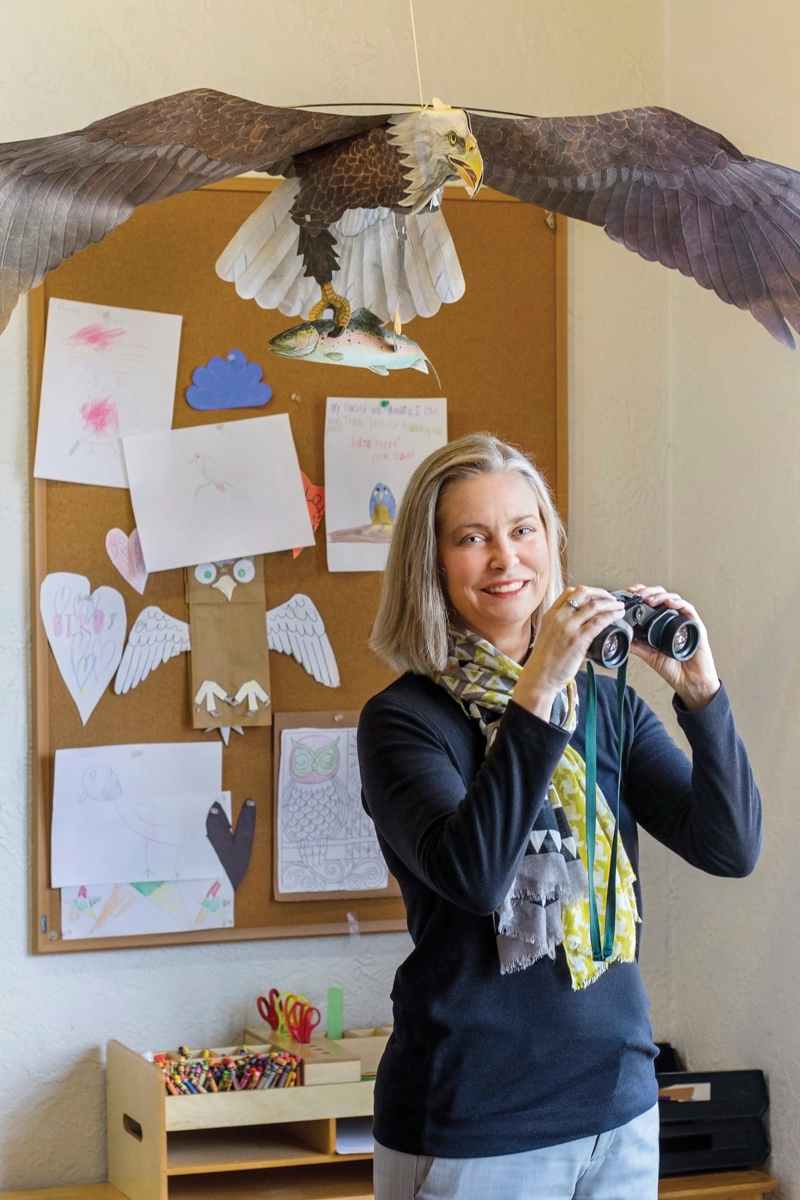
Raptor’s Retreat
Maitland’s Audubon Center for Birds of Prey, one of the region’s best-kept secrets, focuses on the rescue, medical treatment, rehabilitation and release of Florida’s raptors.
The center, which is open to the public, offers educational opportunities for all ages — as well as up-close encounters with its feathered patients. It is operated by Audubon Florida, and is one of several Audubon-related centers and sanctuaries statewide.
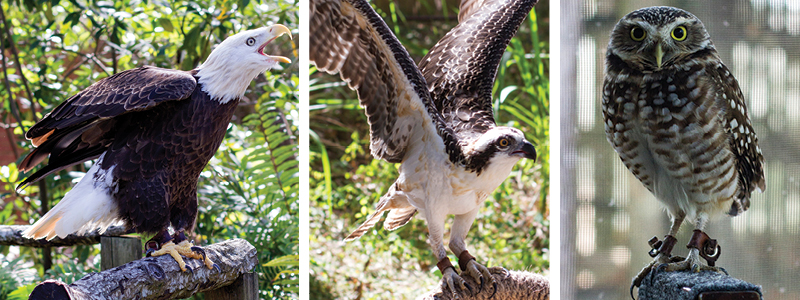
You’ll see bald eagles, ospreys, kites, owls — they are particularly adorable — and falcons. Visitors can wander along a pathway to Disney’s Magic of Flight Barn, which houses birds currently under rehabilitation, and contemplate a man-made wetland over which a gazebo stretches.
It’s a place only Alfred Hitchcock couldn’t love.
Activities include on- and off-site programs, special events, volunteer opportunities and a program called “Eagle Eyes on the Environment,” which uses technology, among other methods, to describe eagle conservation.
The center, which treats about 800 raptors per year, is located at 1101 Audubon Way in Maitland, just off Lake Avenue. Hours are 10 a.m. to 4 p.m. daily except Mondays. Call 407-644-0190 or visit fl.audubon.org for more information.
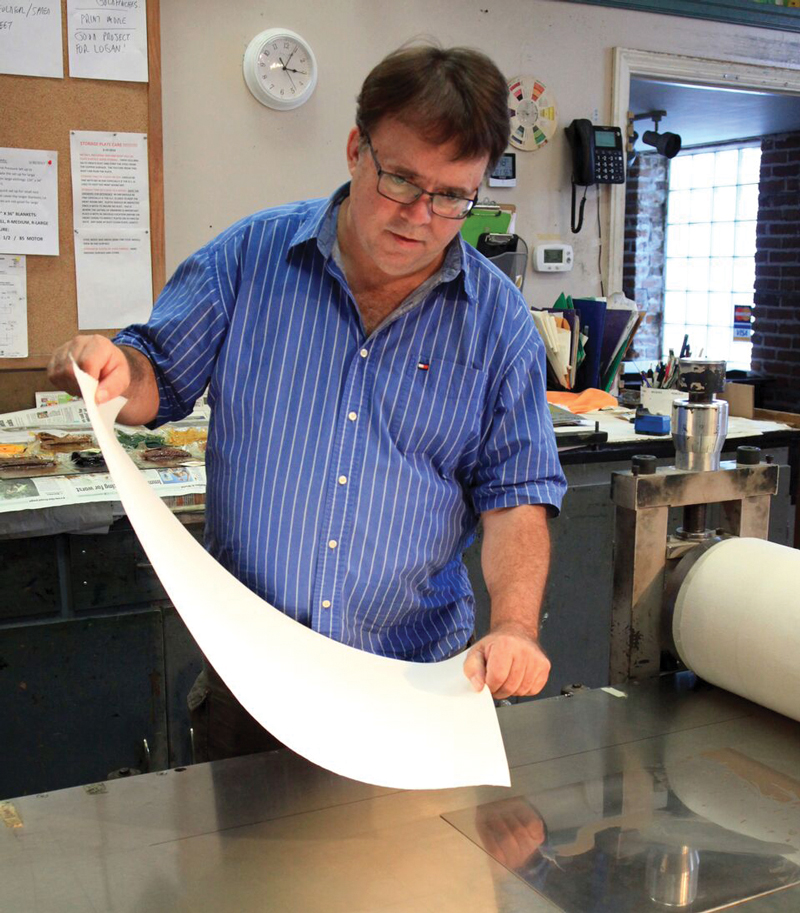
Birds of Paradise: John Costin Just Wings It With His Etchings
If you attended the 2016 Winter Park Sidewalk Art Festival, you saw John Costin’s extraordinarily detailed and vibrant work. His snowy egret was selected as the poster image for the event. At Winter Park Magazine, we were so impressed with Costin’s meticulous etchings that we requested another bird image for the cover of our spring 2016 issue. The Ybor City-based artist supplied an image of a red-shouldered hawk, a bird that particularly enjoys the environs of Mead Garden. We’ve been seeking an excuse to showcase Costin’s work again — and Leslie K. Poole finally gave us one with her story about the Audubon Society of Florida’s beginnings in Maitland. So, accompanying the story are more of Costin’s birds, some species of which can be seen in Mead Botanical Garden and other locations in bird-friendly Winter Park. Etching, by the way, is a complex process in which the image is etched by hand on a polished plate of copper, which takes about six to eight weeks. Then the plate is wiped down with ink and printed on high-quality rag paper. Afterward, the printed image is painted with watercolors, making each piece unique. Visit costingraphics.com for more information about Costin and his art.
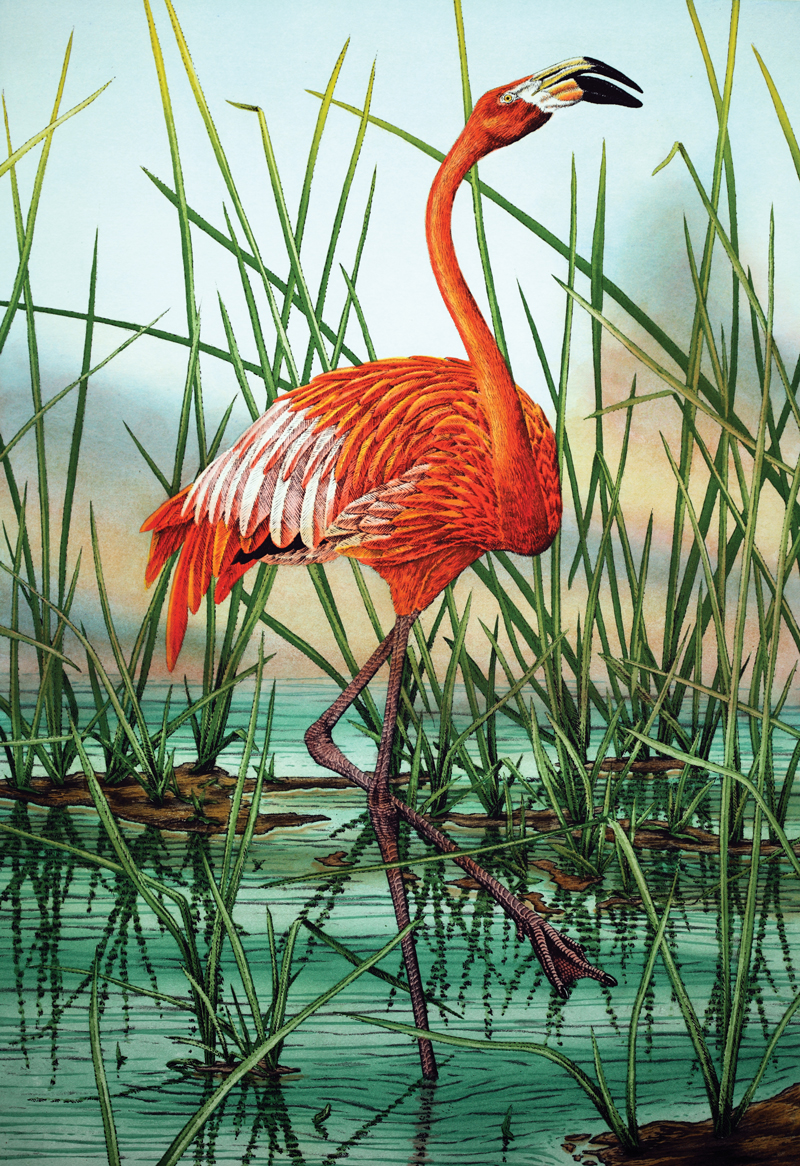
Four-plate, hand-colored etching
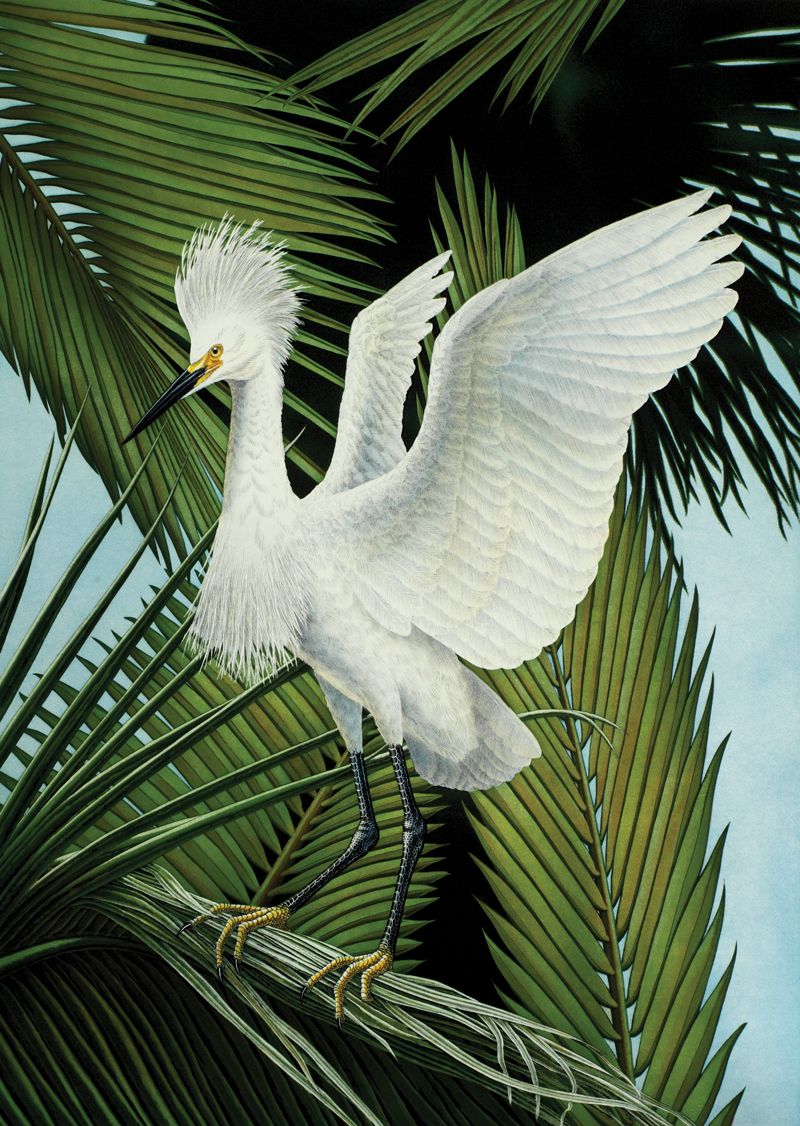
Four-plate, hand-colored etching
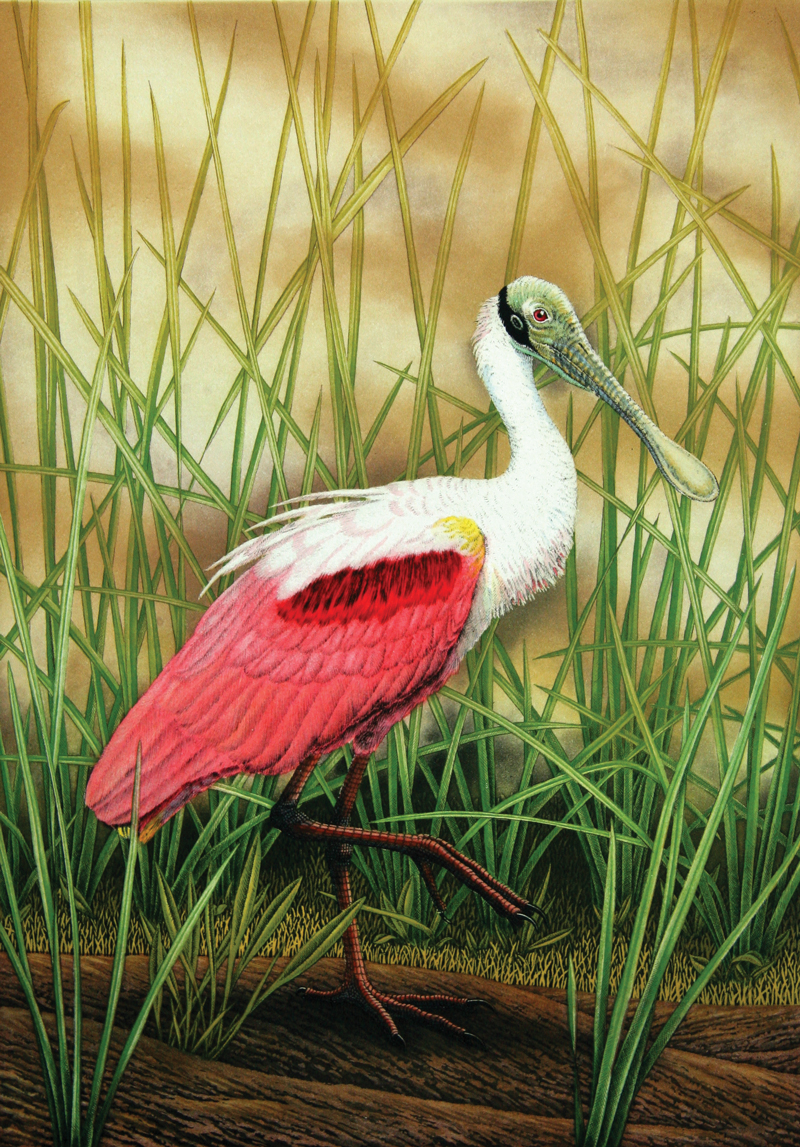
Four-plate, hand-colored etching
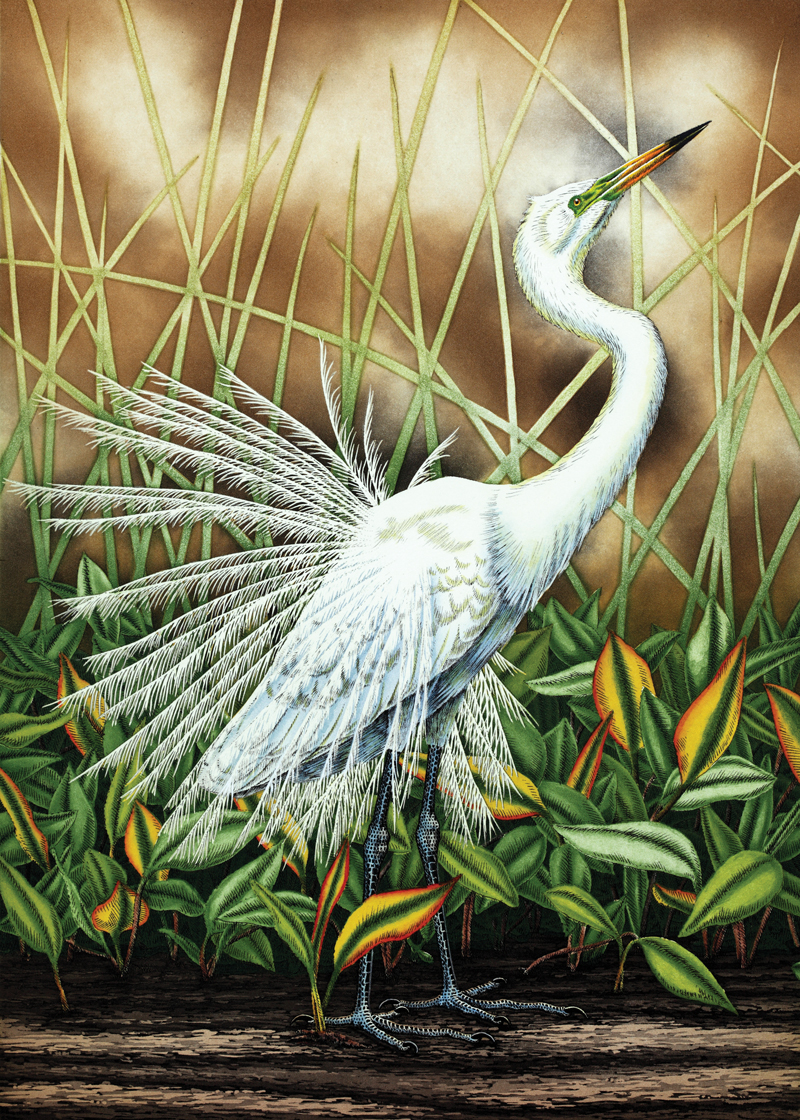
Four-plate, hand-colored etching
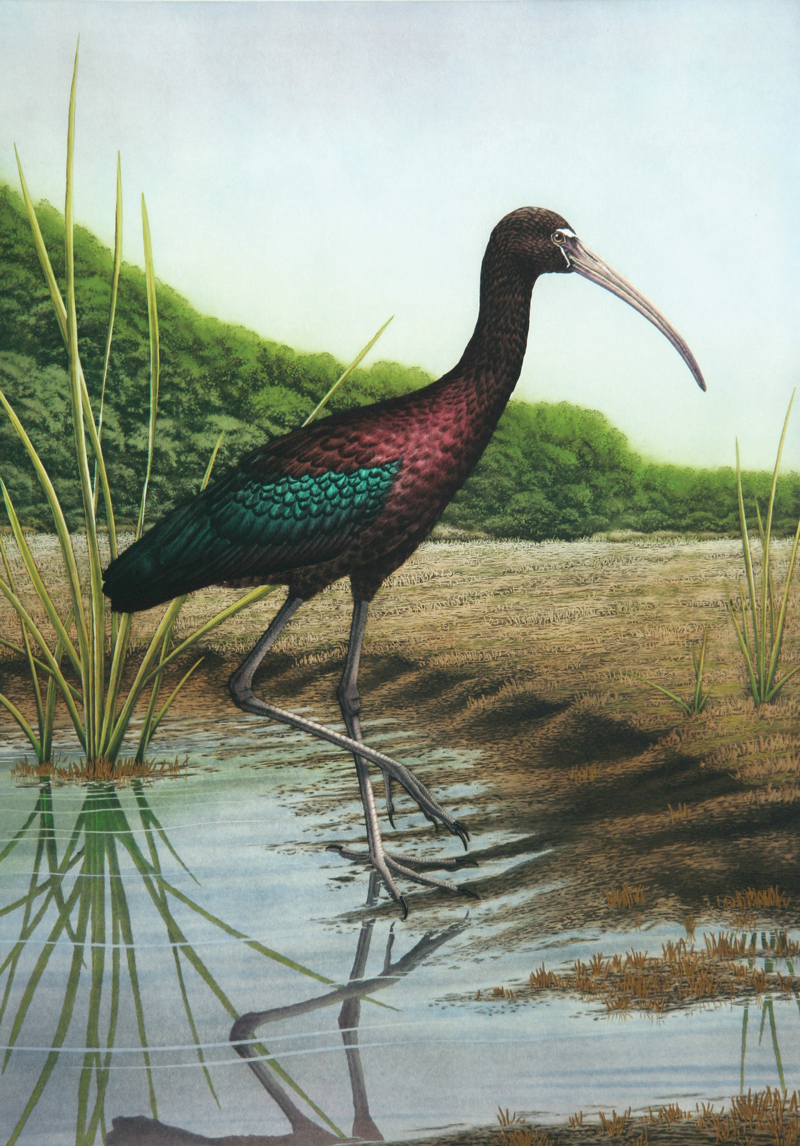
Four-plate, hand-colored etching
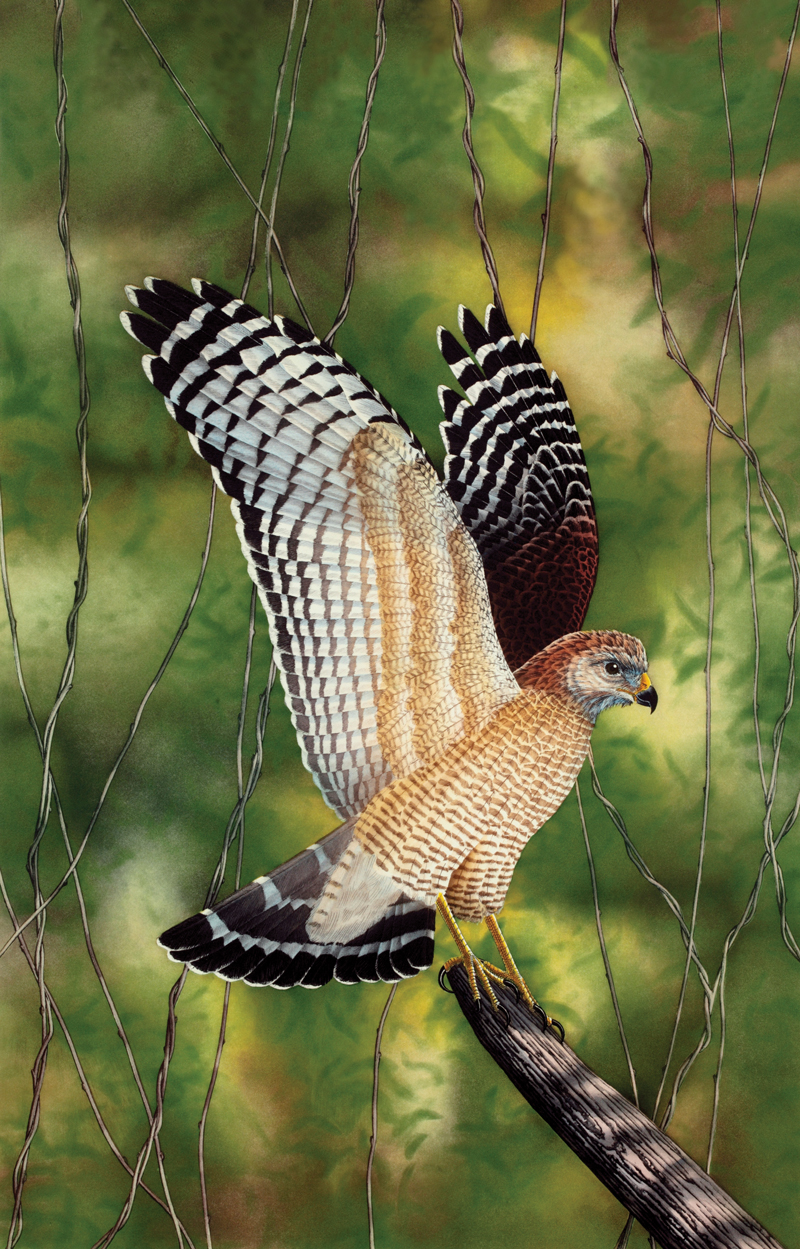
Four-plate, hand-colored etching
Rollins College professor and environmental activist Leslie Kemp Poole (left) visits Maitland’s Audubon Center for Birds of Prey, where you’ll see (below, left to right) bald eagles, ospreys and burrowing owls, among dozens of other recuperating raptors.

